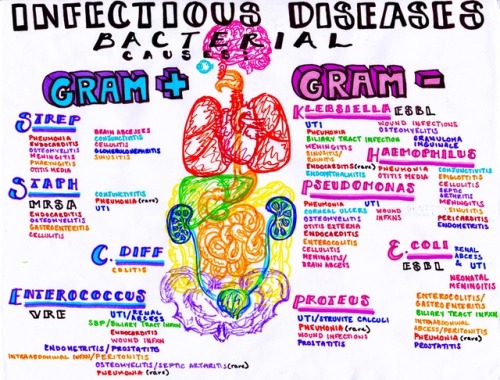The Way Brothers










The Way brothers
More Posts from Ourvioletdeath and Others
Human Drug Addiction Behaviors Closely Tied to Specific Impairments Within Six Large-Scale Brain Networks
Specific impairments within six large-scale brain networks during drug cue exposure, decision-making, inhibitory control, and social-emotional processing are associated with drug addiction behaviors, according to a systematic review of more than 100 published neuroimaging studies by experts at the Icahn School of Medicine at Mount Sinai and published Wednesday, June 6 in the journal Neuron.
Drug addiction is a disorder that encompasses not only excessive drug-seeking and taking, but also fundamental changes in cognition and emotional processing. It comprises core clinical symptoms and behavioral manifestations including a chronically relapsing cycle of intoxication, bingeing, withdrawal, and craving that propels uncontrollable drug use despite adverse consequences and a reduction in the pleasure derived from the drug. While much of the early research on drug addiction focused on understanding the rewarding properties of the drug, recent research has made it increasingly clear that cognitive and emotional impairments support the initiation, escalation, and maintenance of the cycle of addiction. A better understanding of the underlying impaired neural mechanisms in human drug addiction is critical to paving the way for the development of more targeted, evidence-based treatment interventions and timely prevention approaches.
The Impaired Response Inhibition and Salience Attribution (iRISA) model, first published in 2002 by Rita Goldstein, PhD, Professor of Psychiatry and Neuroscience and Director of the Neuropsychoimaging of Addiction and Related Conditions research program at the Icahn School of Medicine at Mount Sinai, and Nora Volkow, Director of NIDA, proposed that impairments of two broad neuropsychological functions—response inhibition (a cognitive process that permits individuals to inhibit their impulses) and salience attribution (the property of tagging something as valuable or important)—and their underlying neural substrates contribute to the cycle of addiction across a broad range of substances of abuse. The iRISA model uses multiple neuroimaging modalities including magnetic resonance imaging, electroencephalogram (EEG) and derived event-related potentials, positron emission tomography, and neuropsychological testing to explore the underlying neurobiology of human drug addiction and the shift to excessive salience attributed to the drug and drug-related cues at the expense of other salient reinforcers as associated with impaired self-control (especially in a drug related context) and increased drug taking in drug addicted individuals.
“We conducted the current review to update the iRISA model with the most recent evidence from the neuroimaging literature by systematically reviewing 105 task-related neuroimaging studies published since 2010,” says Dr. Goldstein, last and senior author of the paper. “We found consistent impairments in brain function in six large-scale brain networks during performance of different tasks. While the involvement of these specific brain networks was task-specific, we generally observed that in a drug-related context (e.g., during exposure to drug cues) drug addicted individuals had increased engagement of the brain networks underlying decision making, inhibitory control, and social-emotional processing, but a blunted response during non-drug related tasks, as predicted by the iRISA model.”
Specifically, the Mount Sinai study team assessed brain function in drug addiction across a number of brain networks, including findings from whole-brain analyses of significant group differences. They organized the results across six large-scale brain networks that showed impairment of brain function in addiction, encompassing the “reward network,” which includes subcortical and cortical brain regions activated during the appraisal of subjective value; the striatal “habit network,” which underlies learning of automated behavior; the “salience network,” regions involved in (re)directing attentional resources toward salient stimuli; and the “executive network,” which supports the selection of possible behavioral responses (often also named the inhibitory control network).
Two additional networks, which were not discussed in prior reviews of the iRISA model, were found to be relevant to brain function in drug addiction: the “self-directed network,” which is activated during self-directed/referential cognitive processes, and the “memory network,” involved in flexible, multi-cue learning and memory.
“Our review is the first systematic approach to integrate what we know about the function of each of these networks into a comprehensive model underlying drug addiction symptomatology across the addiction cycle,” says Anna Zilverstand, PhD, Assistant Professor of Psychiatry at the Icahn School of Medicine at Mount Sinai and first author of the paper. “We demonstrated common deficits underlying drug addiction independent of the primary drug of choice, which are associated with measures of daily, real-life, drug use and which predict onset, escalation, and relapse into drug use. Our work could inform the development of treatments specifically targeted to alleviate these brain-behavioral deficits.”




The Björketorp Runestone & Curse
The Björketorp Runestone is one of many standing stones (menhir) located in Bleking, Sweden and is one of the world’s tallest runestones, measuring 13.7 feet (4.2 m) high. It is part of a stone circle with two other blank standing stones, with several other solitary stones in the surrounding regions. Most scholars date the runestone’s inscription to the 7th century AD. It’s carved with a type of runes that form an intermediate version between the Elder Futhark and the Younger Futhark. The runestone is inscribed on both sides, the shorter message appears to say “I foresee perdition” or “prediction of perdition” and the longer side’s inscription (pictured) translates as:
“I, master of the runes(?) conceal here runes of power. Incessantly (plagued by) maleficence, (doomed to) insidious death (is) he who breaks this (monument). I prophesy destruction / prophecy of destruction.”
Local lore says that the curse came true at one point. Long ago, a man wanted to move the runestone so that he could have more room to farm, so he piled wood around it to attempt to heat the stone and then crack it with water. The weather was calm with no wind at the time, but as soon as he lit the fire a sudden gust came and lit the man’s hair aflame. He dropped to the ground to put it out but his clothes caught fire and the poor man died in agony. The flame around the runestone, however, was miraculously extinguished, as if someone had smothered the fire.

The world is like a video game. Each thing you do affects your stats. Punch something? Your strength increases. Get hit? Your defence increases. Run? You get faster. As long as you do something, you can get better at it. Write about the person who devoted his life to raising his blinking stat.

My contribution to the official Homestuck Calendar 2018! 💛 My assigned month was March so I decided to draw my favourite nerds attending one of the spring Japanese festivals 🏮 They bought lots of anime merchandise, too!

I’m screaming

Infectious bacterial diseases and where to find them

Language is Learned in Brain Circuits that Predate Humans
It has often been claimed that humans learn language using brain components that are specifically dedicated to this purpose. Now, new evidence strongly suggests that language is in fact learned in brain systems that are also used for many other purposes and even pre-existed humans, say researchers in PNAS.
The research combines results from multiple studies involving a total of 665 participants. It shows that children learn their native language and adults learn foreign languages in evolutionarily ancient brain circuits that also are used for tasks as diverse as remembering a shopping list and learning to drive.
“Our conclusion that language is learned in such ancient general-purpose systems contrasts with the long-standing theory that language depends on innately-specified language modules found only in humans,” says the study’s senior investigator, Michael T. Ullman, PhD, professor of neuroscience at Georgetown University School of Medicine.
“These brain systems are also found in animals — for example, rats use them when they learn to navigate a maze,” says co-author Phillip Hamrick, PhD, of Kent State University. “Whatever changes these systems might have undergone to support language, the fact that they play an important role in this critical human ability is quite remarkable.”
The study has important implications not only for understanding the biology and evolution of language and how it is learned, but also for how language learning can be improved, both for people learning a foreign language and for those with language disorders such as autism, dyslexia, or aphasia (language problems caused by brain damage such as stroke).
The research statistically synthesized findings from 16 studies that examined language learning in two well-studied brain systems: declarative and procedural memory.
The results showed that how good we are at remembering the words of a language correlates with how good we are at learning in declarative memory, which we use to memorize shopping lists or to remember the bus driver’s face or what we ate for dinner last night.
Grammar abilities, which allow us to combine words into sentences according to the rules of a language, showed a different pattern. The grammar abilities of children acquiring their native language correlated most strongly with learning in procedural memory, which we use to learn tasks such as driving, riding a bicycle, or playing a musical instrument. In adults learning a foreign language, however, grammar correlated with declarative memory at earlier stages of language learning, but with procedural memory at later stages.
The correlations were large, and were found consistently across languages (e.g., English, French, Finnish, and Japanese) and tasks (e.g., reading, listening, and speaking tasks), suggesting that the links between language and the brain systems are robust and reliable.
The findings have broad research, educational, and clinical implications, says co-author Jarrad Lum, PhD, of Deakin University in Australia.
“Researchers still know very little about the genetic and biological bases of language learning, and the new findings may lead to advances in these areas,” says Ullman. “We know much more about the genetics and biology of the brain systems than about these same aspects of language learning. Since our results suggest that language learning depends on the brain systems, the genetics, biology, and learning mechanisms of these systems may very well also hold for language.”
For example, though researchers know little about which genes underlie language, numerous genes playing particular roles in the two brain systems have been identified. The findings from this new study suggest that these genes may also play similar roles in language. Along the same lines, the evolution of these brain systems, and how they came to underlie language, should shed light on the evolution of language.
Additionally, the findings may lead to approaches that could improve foreign language learning and language problems in disorders, Ullman says.
For example, various pharmacological agents (e.g., the drug memantine) and behavioral strategies (e.g., spacing out the presentation of information) have been shown to enhance learning or retention of information in the brain systems, he says. These approaches may thus also be used to facilitate language learning, including in disorders such as aphasia, dyslexia, and autism.
“We hope and believe that this study will lead to exciting advances in our understanding of language, and in how both second language learning and language problems can be improved,” Ullman concludes.
No specific external funding supported the work. The authors report having no personal financial interests related to the study.
-
 m0nsutazu liked this · 2 months ago
m0nsutazu liked this · 2 months ago -
 panicatthedaria reblogged this · 5 months ago
panicatthedaria reblogged this · 5 months ago -
 panicatthedaria liked this · 5 months ago
panicatthedaria liked this · 5 months ago -
 3-m-1 liked this · 6 months ago
3-m-1 liked this · 6 months ago -
 stranger15 liked this · 7 months ago
stranger15 liked this · 7 months ago -
 mitskisam liked this · 9 months ago
mitskisam liked this · 9 months ago -
 redfishinthesaltyredsea reblogged this · 1 year ago
redfishinthesaltyredsea reblogged this · 1 year ago -
 vampiricgerard liked this · 1 year ago
vampiricgerard liked this · 1 year ago -
 wisherwell liked this · 1 year ago
wisherwell liked this · 1 year ago -
 qiaoan-joannnnn liked this · 1 year ago
qiaoan-joannnnn liked this · 1 year ago -
 humanoidbean liked this · 1 year ago
humanoidbean liked this · 1 year ago -
 tears-of-the-angel liked this · 2 years ago
tears-of-the-angel liked this · 2 years ago -
 emo69420 liked this · 2 years ago
emo69420 liked this · 2 years ago -
 h-ellblazer liked this · 2 years ago
h-ellblazer liked this · 2 years ago -
 s2neko liked this · 2 years ago
s2neko liked this · 2 years ago -
 nicheincreation liked this · 2 years ago
nicheincreation liked this · 2 years ago -
 happed05 liked this · 2 years ago
happed05 liked this · 2 years ago -
 killedanhour reblogged this · 2 years ago
killedanhour reblogged this · 2 years ago -
 rottenpi liked this · 2 years ago
rottenpi liked this · 2 years ago -
 meowchemicalromance reblogged this · 2 years ago
meowchemicalromance reblogged this · 2 years ago -
 cerealsnail liked this · 2 years ago
cerealsnail liked this · 2 years ago -
 lovedbymisery liked this · 3 years ago
lovedbymisery liked this · 3 years ago -
 manchesterbands liked this · 3 years ago
manchesterbands liked this · 3 years ago -
 weirdgrrlgerard liked this · 3 years ago
weirdgrrlgerard liked this · 3 years ago -
 constantbellpepper liked this · 3 years ago
constantbellpepper liked this · 3 years ago -
 svmetal liked this · 3 years ago
svmetal liked this · 3 years ago -
 hopelessxfrnksblog liked this · 4 years ago
hopelessxfrnksblog liked this · 4 years ago -
 joseplascenciajpg liked this · 4 years ago
joseplascenciajpg liked this · 4 years ago -
 m0rniingstar liked this · 4 years ago
m0rniingstar liked this · 4 years ago -
 lilyiisworld liked this · 4 years ago
lilyiisworld liked this · 4 years ago -
 girl-strong reblogged this · 4 years ago
girl-strong reblogged this · 4 years ago -
 girl-strong liked this · 4 years ago
girl-strong liked this · 4 years ago -
 elgatodistopico reblogged this · 4 years ago
elgatodistopico reblogged this · 4 years ago